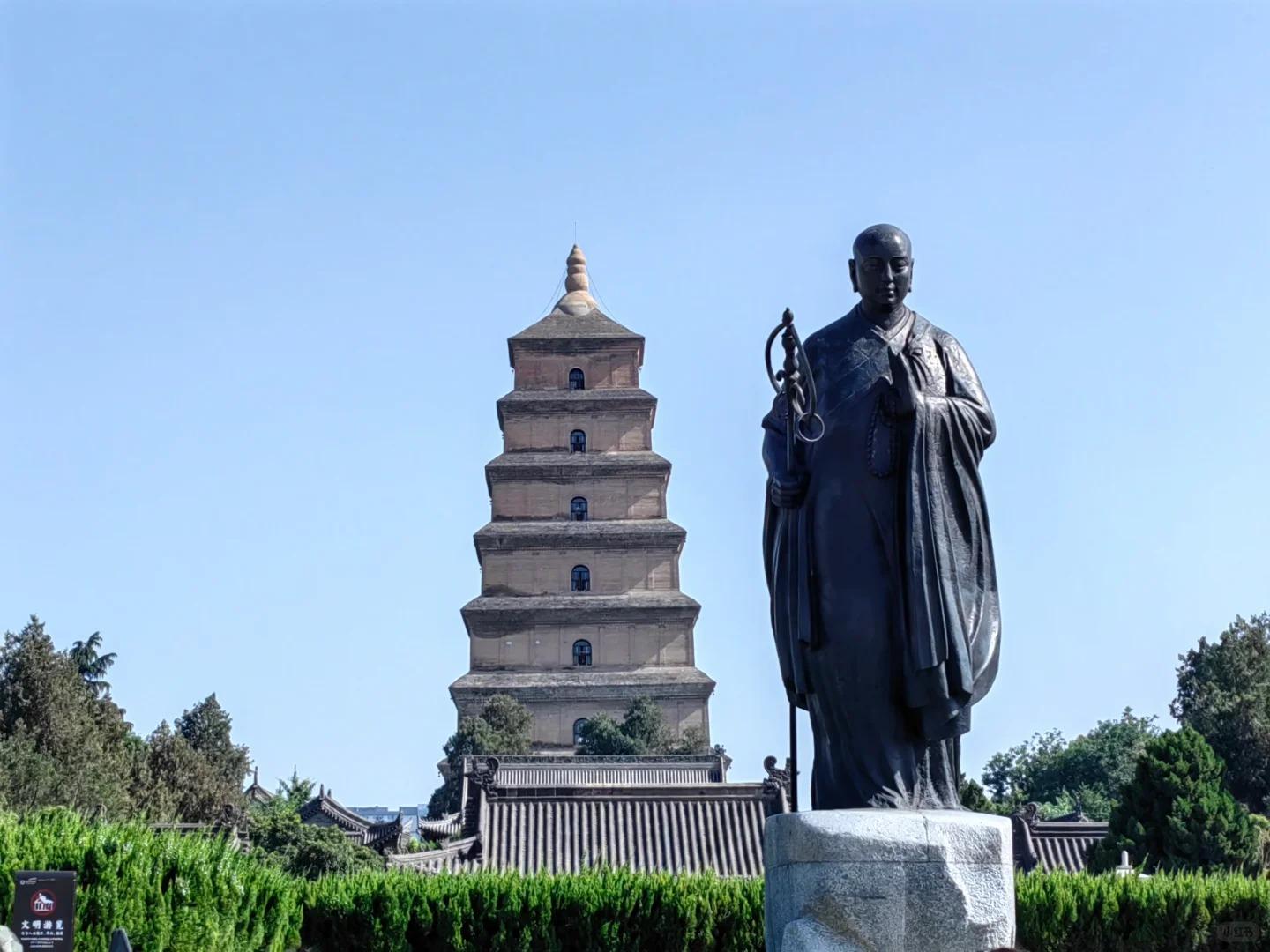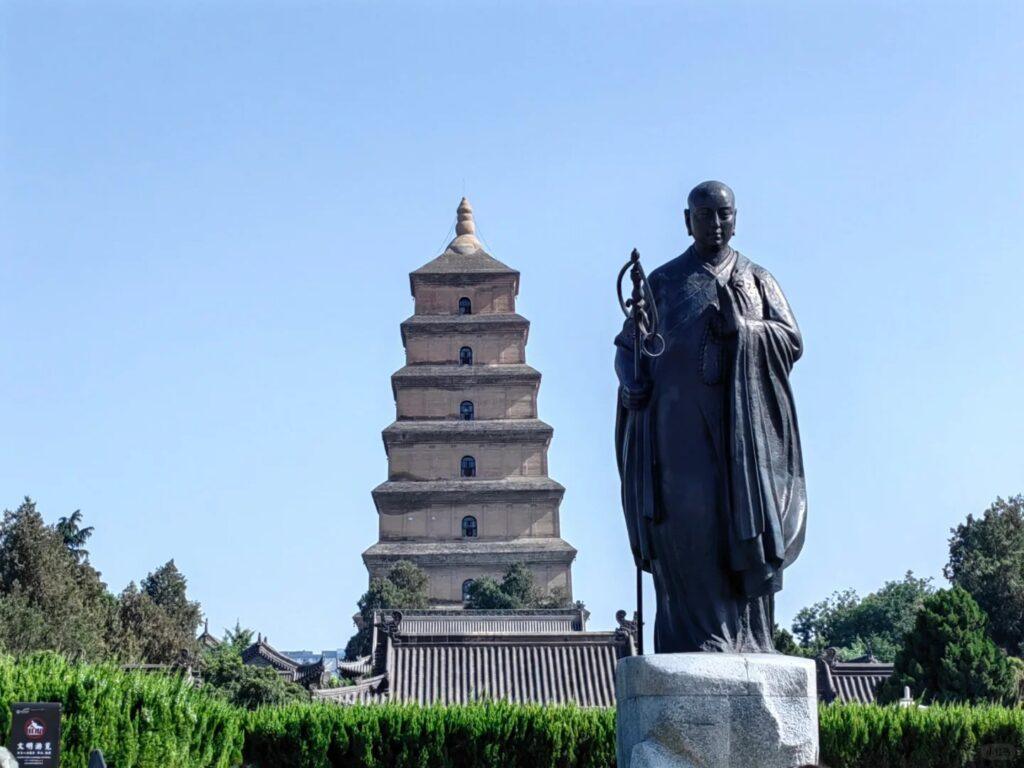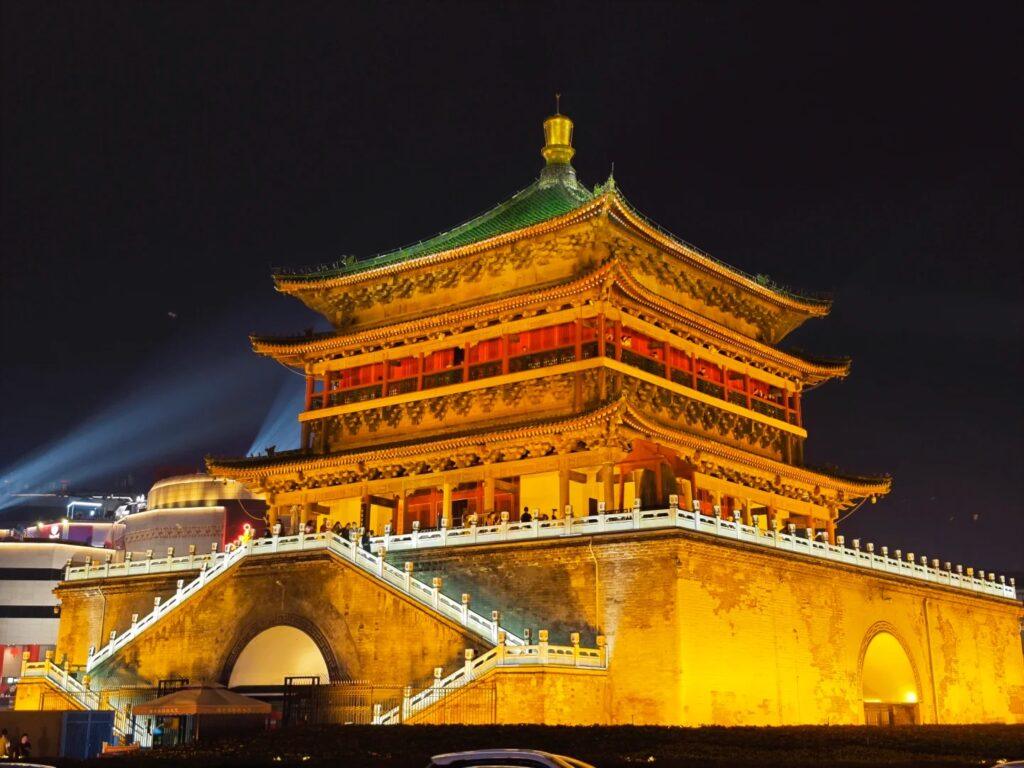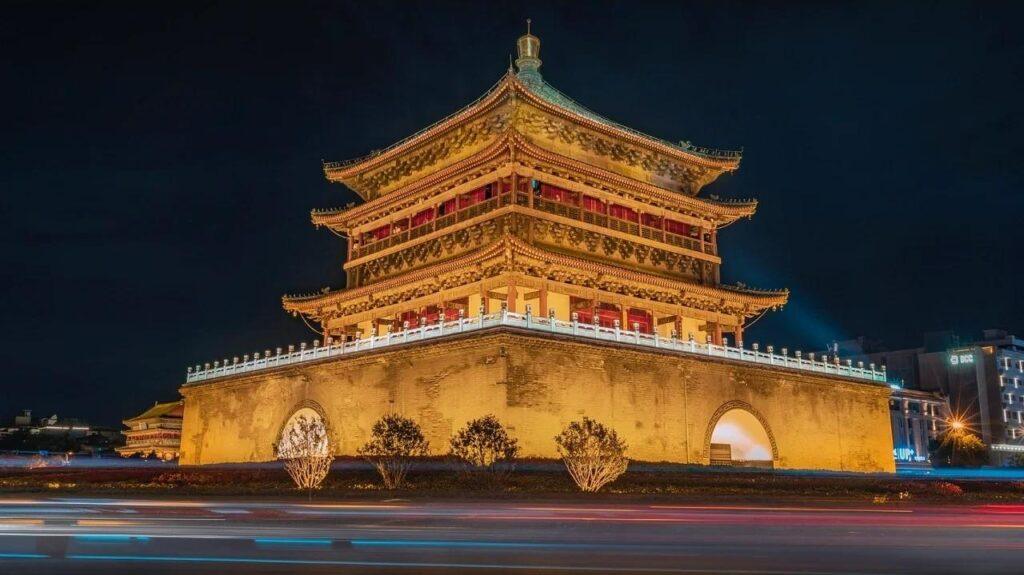Visiting Information
| Information | Details |
|---|---|
| Chinese Name | 大雁塔 (Dàyàn Tǎ) |
| Location and Address | Yanta West Road, Yanta District, Xi’an, Shaanxi Province, China |
| Opening Time/Hours | 8:00 AM – 5:00 PM (March to November) 8:00 AM – 5:00 PM (December to February) |
| Entrance Fee | 50 CNY (Pagoda only) 50 CNY (Da Ci’en Temple) 80 CNY (Combined ticket) |
| How to Get There | By Metro: Line 3 or Line 4 to Dayanta Station, Exit C By Bus: Take bus 5, 19, 24, 30, 34, 218, 221, 222, 258, 258, 320, 400, 401, 521, 527, 610, 701 or Tourist Line 8 (610) to Big Wild Goose Pagoda station By Taxi: Tell the driver “Dayan Ta” (大雁塔) |
| Best Time for Visit | Spring (March to May) and Autumn (September to November) |
| Contact Info | +86 29 8526 8292 |
Overview
The Big Wild Goose Pagoda, located in Xi’an, China, is one of the most famous Buddhist pagodas in China. Built in 652 during the Tang Dynasty, this architectural marvel stands as a symbol of Xi’an’s rich history and Buddhist heritage. The pagoda was originally constructed to house Buddhist sutras and figurines brought from India by the famous Buddhist monk Xuanzang.
Historical Background
The Big Wild Goose Pagoda was built during the reign of Emperor Gaozong of the Tang Dynasty. Its primary purpose was to store the Buddhist scriptures and statues that Xuanzang had brought back from his 17-year pilgrimage to India. The pagoda has undergone several renovations and reconstructions over the centuries, with the current structure dating back to the Ming Dynasty (1368-1644). It has survived numerous natural disasters and wars, standing as a testament to ancient Chinese architectural prowess and the enduring influence of Buddhism in China.

Architectural Features
- Structure: The Big Wild Goose Pagoda is a square brick tower with seven stories, reaching a height of 64 meters (210 feet). Each story is smaller than the one below, creating a tapered appearance that is characteristic of Tang Dynasty architecture.
- Exterior Design: The exterior of the pagoda features intricate carvings and decorations typical of Buddhist architecture. The eaves of each level are adorned with upturned corners, giving the structure an elegant and imposing appearance.
- Interior Layout: Inside the pagoda, a spiral staircase allows visitors to climb to the top. Each floor contains small chambers that once housed Buddhist artifacts and scriptures. The walls are adorned with ancient inscriptions and Buddhist artwork.
- Surrounding Complex: The pagoda is part of the larger Da Ci’en Temple complex, which includes various halls, courtyards, and gardens designed in traditional Chinese architectural style.
Cultural Importance
The Big Wild Goose Pagoda holds immense cultural significance in China. It symbolizes the introduction and spread of Buddhism in China, particularly during the Tang Dynasty when Xi’an (then Chang’an) was the capital and a major center of cultural exchange. The pagoda is closely associated with Xuanzang, whose journey to India greatly influenced the development of Buddhism in China. Today, it serves as a important pilgrimage site for Buddhists and a symbol of Xi’an’s historical importance as the eastern terminus of the Silk Road.
Surrounding Attractions
- Da Ci’en Temple: This ancient Buddhist temple complex surrounds the Big Wild Goose Pagoda. It features several halls dedicated to various Buddhas and Bodhisattvas, offering visitors a glimpse into traditional Chinese Buddhist architecture and practices.
- North Square of Big Wild Goose Pagoda: This large public square features Asia’s largest musical fountain. In the evenings, visitors can enjoy spectacular water shows synchronized with music and lights.
- Shaanxi History Museum: Located nearby, this museum houses over 370,000 artifacts that showcase the rich history of Shaanxi Province, including relics from the Zhou, Qin, Han, and Tang dynasties.
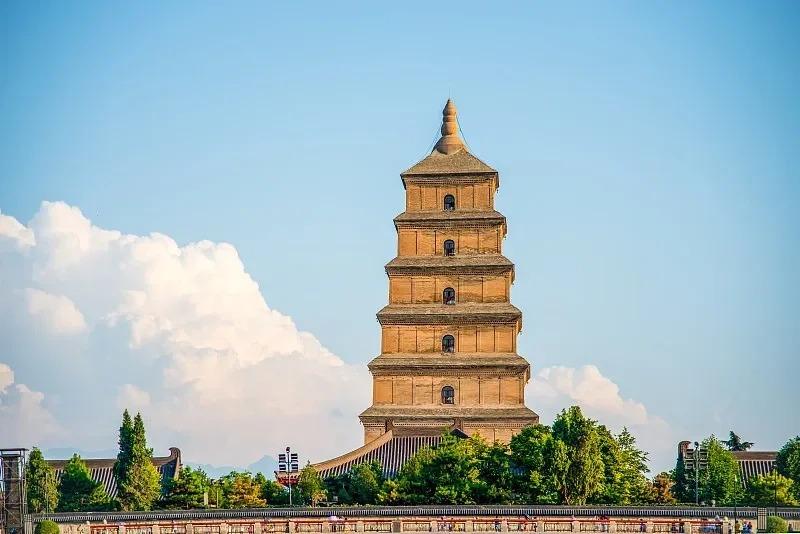
Photography Opportunities
- Pagoda Exterior: The imposing structure of the Big Wild Goose Pagoda offers excellent opportunities for architectural photography. The best shots can be taken from the North Square, where you can capture the entire pagoda against the sky.
- Panoramic Views: Climbing to the top of the pagoda provides a panoramic view of Xi’an city, offering unique photo opportunities of the urban landscape juxtaposed with this ancient structure.
- Musical Fountain Show: The evening water shows at the North Square present spectacular scenes for night photography, with colorful lights and water jets creating dynamic compositions.
Modern Importance
- Cultural Heritage Preservation: The Big Wild Goose Pagoda serves as a prime example of China’s efforts to preserve its ancient cultural heritage. Its ongoing maintenance and restoration work showcase modern conservation techniques applied to ancient structures.
- Tourism: As one of Xi’an’s most recognizable landmarks, the pagoda plays a crucial role in the city’s tourism industry, attracting millions of visitors annually and contributing significantly to the local economy.
- Educational Value: The pagoda and its surrounding complex serve as an important educational resource, offering insights into ancient Chinese architecture, Buddhism, and the cultural exchanges that occurred along the Silk Road.
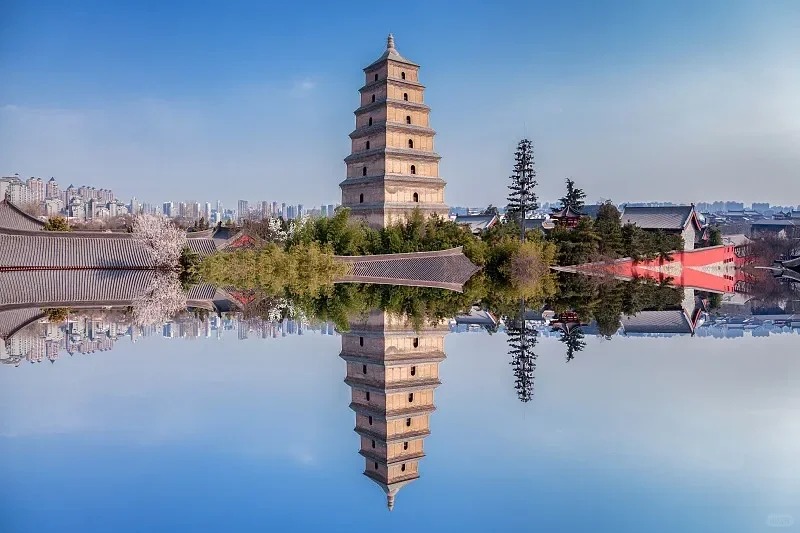
FAQ
- What is Big Wild Goose Pagoda famous for?
Big Wild Goose Pagoda is famous for its historical significance, architectural beauty, and its association with the famous Buddhist monk Xuanzang. It’s one of the best-preserved Buddhist pagodas from the Tang Dynasty. - What’s inside Big Wild Goose Pagoda?
Inside the pagoda, visitors can find Buddhist scriptures, statues, and relics. Each floor contains small chambers, and there’s a spiral staircase leading to the top, offering panoramic views of Xi’an. - Is Big Wild Goose Pagoda free?
No, Big Wild Goose Pagoda is not free. There is an entrance fee of 50 CNY for the pagoda alone, or 80 CNY for a combined ticket including the Da Ci’en Temple complex. - Is Big Wild Goose Pagoda worth visiting?
Yes, Big Wild Goose Pagoda is definitely worth visiting. It offers a unique blend of history, architecture, and cultural significance, making it a must-see attraction in Xi’an. - What to do in Big Wild Goose Pagoda?
Visitors can climb the pagoda for panoramic views, explore the Da Ci’en Temple complex, watch the musical fountain show in the North Square, and learn about Buddhist history and culture. - How do I get to Big Wild Goose Pagoda in the local city?
In Xi’an, you can reach Big Wild Goose Pagoda by taking Metro Line 3 or 4 to Dayanta Station and using Exit C. Alternatively, numerous bus lines stop at the Big Wild Goose Pagoda station. - How to visit Big Wild Goose Pagoda?
Visit during opening hours (8:00 AM – 5:00 PM). Purchase a ticket at the entrance. Start with exploring the pagoda itself, then visit the surrounding Da Ci’en Temple complex. If possible, stay for the evening musical fountain show in the North Square. Allow at least 2-3 hours for a comprehensive visit.



